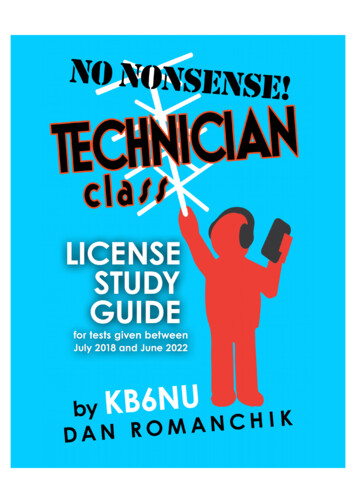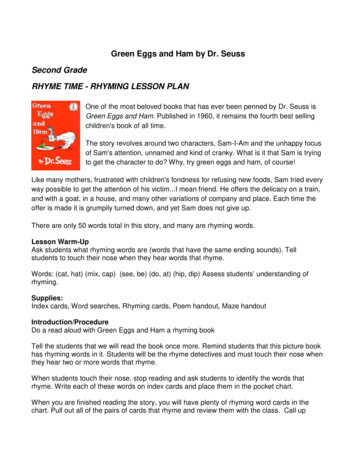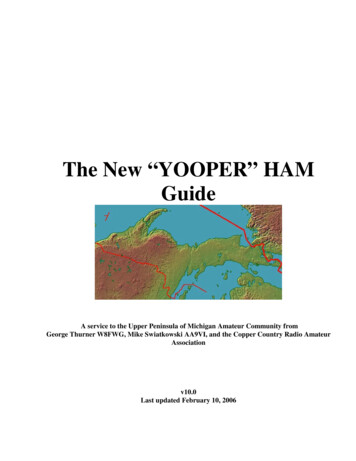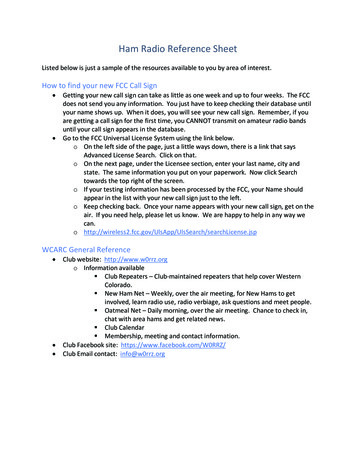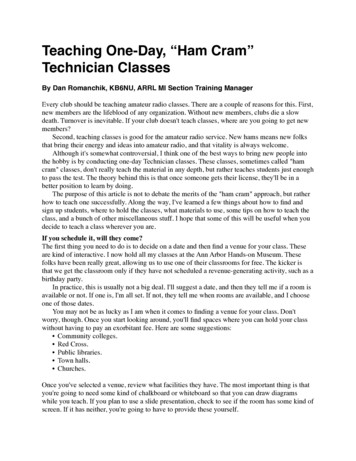
Transcription
Teaching One-Day, “Ham Cram”Technician ClassesBy Dan Romanchik, KB6NU, ARRL MI Section Training Manager!Every club should be teaching amateur radio classes. There are a couple of reasons for this. First,new members are the lifeblood of any organization. Without new members, clubs die a slowdeath. Turnover is inevitable. If your club doesn't teach classes, where are you going to get newmembers?Second, teaching classes is good for the amateur radio service. New hams means new folksthat bring their energy and ideas into amateur radio, and that vitality is always welcome.Although it's somewhat controversial, I think one of the best ways to bring new people intothe hobby is by conducting one-day Technician classes. These classes, sometimes called "hamcram" classes, don't really teach the material in any depth, but rather teaches students just enoughto pass the test. The theory behind this is that once someone gets their license, they'll be in abetter position to learn by doing.The purpose of this article is not to debate the merits of the "ham cram" approach, but ratherhow to teach one successfully. Along the way, I've learned a few things about how to find andsign up students, where to hold the classes, what materials to use, some tips on how to teach theclass, and a bunch of other miscellaneous stuff. I hope that some of this will be useful when youdecide to teach a class wherever you are.If you schedule it, will they come?The first thing you need to do is to decide on a date and then find a venue for your class. Theseare kind of interactive. I now hold all my classes at the Ann Arbor Hands-on Museum. Thesefolks have been really great, allowing us to use one of their classrooms for free. The kicker isthat we get the classroom only if they have not scheduled a revenue-generating activity, such as abirthday party.In practice, this is usually not a big deal. I'll suggest a date, and then they tell me if a room isavailable or not. If one is, I'm all set. If not, they tell me when rooms are available, and I chooseone of those dates.You may not be as lucky as I am when it comes to finding a venue for your class. Don'tworry, though. Once you start looking around, you'll find spaces where you can hold your classwithout having to pay an exorbitant fee. Here are some suggestions: Community colleges. Red Cross. Public libraries. Town halls. Churches.Once you've selected a venue, review what facilities they have. The most important thing is thatyou're going to need some kind of chalkboard or whiteboard so that you can draw diagramswhile you teach. If you plan to use a slide presentation, check to see if the room has some kind ofscreen. If it has neither, you're going to have to provide these yourself.
It's also important that the room has enough space for the number of students that you expect.You don't, for example, want to have to cram ten or twelve people into a small conference roomthat's designed to accommodate only half than number.Another scheduling consideration is whether or not you can get Volunteer Examiners (VEs). Iam fortunate that my club has a great VE team that is very accommodating. There are many VEson the team, and in the last few years, I’ve only had to give them the time, date, and location, andthe team has shown up. Your mileage may vary on this.Putting butts in seatsThe next thing that you have to do is find students for your class. The first place to start is yourown club. The club members may all have licenses, but they may also have family members,neighbors, or co-workers that have shown an interest in amateur radio. Get them to pass on yourclass information to these folks. Other ways to advertise your class include: Send out a notice to clubs in your area. I get the e-mail addresses of the newsletter editorsof amateur clubs within 50 miles of Ann Arbor, MI (where I live) by going to http://www.arrl.org/find-a-club. I then send them a short description of the class and ask that theyput this information in their club newsletter. This always results in a student or two.Also, check to see if there are any hacker or maker groups in your area and send themnotices, too. These groups are great places to recruit new hams. Tell your section manager and ACC. Send an e-mail to your section manager (SM) andaffiliated club coordinator and ask them to let people know. The SM puts out a monthlynewsletter that goes to every ARRL member in your section, and so is a good way to getthe word out. ARRL Find-a-Class. If you're a registered volunteer instructor, you can list your class onthe ARRL website by going to http://www.arrl.org/list-a-license-class. To be honest, I'm notsure if I've ever gotten a student from this service, but it's not hard to list your class, so you
might as well do so. By the way, if you're not a registered volunteer instructor already, goto http://www.arrl.org/volunteer-instructors-mentors and sign up. There are some benefitsto doing so, and it doesn't cost anything. Newspapers, magazines. Send in an event listing to your local newspapers and magazines.Many of these publications now have online calendars that list all kinds of different publicevents, and because there are no space limitations, nearly every event gets into the calendar. Post flyers. Another thing you might think about doing is to post flyers around town ingrocery stores, coffee houses, libraries, etc.The notices and flyers that I send out include the time and date of the class, a basic description ofthe class, a link to the study guide on my website (I use my own study guide, of course), and mycontact information. Whenever anyone contacts me about the class, I record their name and email address in a spreadsheet. They may not be able to attend this class, but if you keep them onthe list and notify them when you schedule subsequent classes, you'll get them to attend sooneror later, if they are really interested. This list is really the cornerstone of my recruiting efforts.Free or fee?Before you send out notices, you need to decide whether or not you're going to charge a fee forthe class. At first, I did not charge a fee. The problem with this approach is that some studentsjust didn't bother to show up.So, about a year ago, I started charging a 10 fee and I require that they send me this feebefore the class. I accept checks and PayPal. This has definitely improved attendance. My theoryis that once they've paid, they're less likely to just skip the class. And, before you get the idea thatI'm getting rich off the students, let me add that all the money I collect goes towards the expenseof maintaining and enhancing our club station, WA2HOM, at the Hands-On Museum.Choosing a study guideBefore you start teaching, you're going to have to decide on what study guide you tell students toget. For me, this is a no-brainer. I wrote my own! You can find it on my website at http://www.kb6nu.com/tech-manual/. Students can download a free version, buy an e-book versionfrom Amazon or Barnes&Noble, or buy a printed version from me directly.As the name implies, my No-Nonsense Technician Class License Study Guide is astraightforward guide to passing the Tech test. What I did was to first take each question in thequestion pool and reword them as statements. Then, I re-arranged them so that related questionsappear next to one another and added text to give the questions some context. It doesn't go verydeeply into each topic, but it does give readers enough context so that they understand the intentof the question and perhaps why it's important to know the answer.There are plenty of other study guides available. You can have them purchase one from theARRL or obtain one of the other free ones out there.Whichever one you choose, I think it's important that you stress that the students prepare forthe class by reading through the study guide at least once or twice. There is, after all, a limit onhow much you can cram into them in seven hours. I have found that most of the students whofail the test after my class did not prepare at all, thinking that they could wing it. They shouldalso take some online practice tests, so that they can judge how much they already know andprepared to ask questions about the test questions that the don't understand. I tell them that ifthey do not prepare, the chances are that they will fail the test.Teaching the class
I wrote my study guide with the one-day Tech class in mind. I like to cover the technical topicsfirst, when the students are still relatively fresh, so the first thing I cover in class is electricalprinciples, not FCC regulations, which is what the first section of the question pool covers.Here's my list of topics: Electrical Principles Electronic principles and components Radio and electromagnetic wave properties Antennas and Feedlines Amateur Radio Signals Safety Station Setup and Operation Operating Procedures Rules and RegulationsThe class starts promptly at 8:30 am. I don’t wait for everyone to show up. There is a lot ofmaterial to cover, and I don’t think that it’s fair to make those that show up on time wait for thetardy folks.The first thing we do is introduce ourselves, just like you might do at a ham radio clubmeeting. Then, I tell them where the rest rooms are, when we’ll be taking breaks, and perhapssome other “housekeeping” kinds of things. I make it clear that we’re going to have to reallyfocus to get through all the material by 3:00 pm.After the introduction, I pretty much follow the study guide page-by-page. I talk a little bitabout the concepts, then cover the questions. So, for example, I talk about what voltage andcurrent are, and then say something like, “The question on the test is, ‘What is the electrical termfor the electromotive force (EMF) that causes electron flow.’ Answer: voltage. Question: ‘Whatis the basic unit of electromotive force?’ Answer: the volt.” I often repeat the answer foremphasis.I tell lots of stories from my own personal experience. For example, in the section“Troubleshooting common problems,” there’s a question, “What are some useful things to try incorrecting a radio frequency interference problem?” The answer is “All of these choices arecorrect,” with the other choices being snap-on ferrite chokes, low-pass and high-pass filters, andband-reject and band-pass filters.The story that I tell to make the point is about when I first set up a 40m dipole at my currentQTH. I built the antenna, strung it up between the house and a tree, and when I put the antennaanalyzer on it, found that it didn’t even require any tuning. Feeling pretty good about myself, Iheaded down to the shack to make a few contacts with it.Well, as soon as I started calling CQ, my wife stormed into the shack. “What are you doing?”she asked. Taken totally by surprise, I answered, “I’m just making a few contacts.” “Well,” shesaid, “You’re making the garage door go up and down.”As it turned out, there was enough RF being coupled into wires connecting the garage dooropener to the switch on the wall that I was indeed opening and closing the garage door.Fortunately, I had some snap-on ferrite chokes and putting one at the garage door opener inputfixed the problem.Watch the time
While anecdotes are great, don’t go overboard. The reason for this is that it’s very important thatyou move quickly through the material, so that you cover everything. One time, I found myselfrunning out of time, so I skipped some questions on the International Telecommunications Union(ITU). After the test session, one of the Volunteer Examiners pulled me aside and said, “Dan,nearly all the students missed the question on the ITU. Next time, you might want to make sureto cover that.” Fortunately, none of the students in that class failed the test, but I would have feltreally bad if one of them had failed by one question.The same goes for questions from the students. I encourage the students to ask questions, butyou have to be careful that when answering them that you don’t get too long-winded or too offtopic. Remember how much material that you have to get through by 3:00 pm.The way I keep myself on time is to continually watch the clock, keeping in mind how manypages I’ve already covered and how many pages I have yet to cover. My study guide has 44pages of material, so I try to make it through page 20, the section on Amateur Radio Signals, bythe lunch break. The material after that is less technical and can be covered more quickly.Talking about breaks, we take a half-hour lunch break and two 10-15 minute breaks. Isuggest that people bring a bag lunch so that they don’t take more than a half hour for lunch. Ialways bring one myself, so that I can chat with the students and perhaps answer off-topicquestions. Just as I start on time at 8:30 am, I also don’t extend the breaks.Another tip to save time is to draw the schematic diagrams in Figures T1, T2, and T3 on thechalkboard or whiteboard before the class starts. This will allow you to do a nice job drawingthem, and not take up valuable class time doing so.No PowerPoints!That pretty much covers it as far as my teaching method goes.You’ll notice that I made no mention of PowerPointpresentations. I don’t use them. Not only that, I think thatthey’re bad for a class like this. They slow you down and putthe students to sleep. You need to be dynamic and engagingand interesting to keep the students involved and awake.When was the last time you sat through a dynamic andengaging PowerPoint presentation? Here are some othermiscellaneous thoughts: This is not a great format for teaching kids. Becausethere is so much material to cover in such a short time, itrequires a lot of focus. Many kids don’t have that kind offocus. Having said that, I have had kids in the class, andthey have passed the test afterwards. The most memorable were two brothers, aged 10 and12. As I was explaining the different forms of the Ohm’s Law equation, I said, “This issimple algebra.” As soon as they heard me say that, they shouted, “But, we haven’t hadalgebra yet!” I made sure to pay special attention to these boys during the class, and keepthem engaged by asking them questions throughout. I’m happy to say that they bothpassed. Tag-team approach. When I first started teaching this class, and from time to timeafterwards, I have taught this class with a partner. When you have a partner, one can do thelecturing while the other reads off the appropriate questions and answers. This approachhas worked well, and takes some stress off a single teacher.
Evaluation form. I haven’t had the students fill out an evaluation form in the past, but I’mplanning to start using one. This should be a good source of feedback, and it will help youimproved your class. Follow up classes. I currently don’t teach any follow-up classes, but have heard of someclubs that do. The follow-up classes teach things like how to program an HT, how to buildan antenna, how to participate in a net, and other topics like that. While I don’t have formalclasses to teach my students these things, I do tell them to feel free to e-mail me withquestions, or come down to our club station when I’ll be there, and I can help them one-onone. Some of them actually take me up on my offer, and I’ve become good friends withsome of them. General class. Soon after you’ve helped a number of folks get their Tech licenses, you’llget asked to conduct a General class. I’ve taught several of these, and have had goodsuccess with them. I use a more traditional approach for these classes. They consist of eightto ten, two-hour sessions and covered the material in more depth. That is to say I didn’t justteach the answers to the questions in the question pool.I hope that this article has encouraged you to run one of these classes where you are, or, if youalready conduct them, I hope that it has given you some ideas on how to improve your classes.I’d love to hear about what’s worked for you and what hasn’t. Please feel free to e-mail me atcwgeek@kb6nu.com or to phone me at 734-930-6564.
About the AuthorI have been a ham radio operator since 1971 and a radioenthusiast as long as I can remember. In addition tobeing an active CW operator on the HF bands: I blog about amateur radio at KB6NU.Com, oneof the leading amateur radio blogs on the Internet. I am the author of the No-Nonsense TechnicianClass License Study Guide and the No-NonsenseGeneral Class License Study Guide. These studyguides are available as a free PDF file, in e-bookformat, and even in a traditional print version. Seehttp://www.kb6nu.com/tech-manual for moreinformation. I send out a monthly column to more than 300amateur radio clubs in North America forpublication in their newsletters. I am the station manager for WA2HOM (http://www.wa2hom.org), the amateur radio station at the Ann Arbor Hands-On Museum (http://www.aahom.org). I teach amateur radio classes around the state of Michigan. I serve as the ARRL Michigan Section Training Manager and conduct amateur radioleadership workshops for amateur radio club leaders in Michigan.You can contact me by sending e-mail to cwgeek@kb6nu.com. If you have comments orquestion about any of the stuff in this book, I hope you will do so.73!Dan Romanchik, KB6NU
Teaching One-Day, “Ham Cram” Technician Classes By Dan Romanchik, KB6NU, ARRL MI Section Training Manager! Every club should be teaching amateur radio classes. There are a couple of reasons for this. First, new members are the lifeblood of any organization. Without new

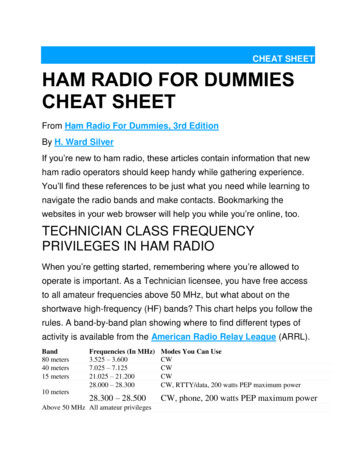
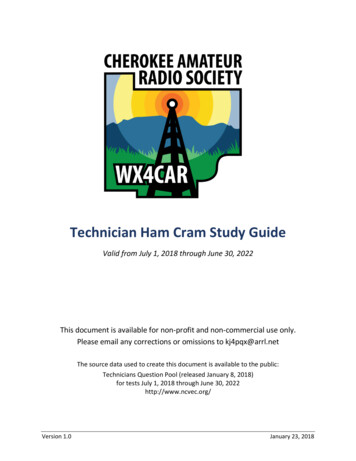
![Welcome [dashdiet.me]](/img/17/30-day-weight-loss-journal.jpg)



